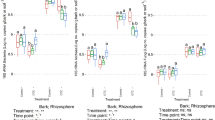Abstract
The relative importance of extractive content and its chemical compounds in imparting brown-rot decay resistance of teak wood was determined using HPTLC. Total extractive content (12.44%), tectoquinone (0.23%) and naphthoquinone (0.62%) were lower in home garden teak of wet site than of dry site with corresponding values of 15.98%, 0.34% and 1.26% in the latter. The amount of napthoquinone was more consistently correlated with higher decay resistance from the wet to the dry and planted sites implying that napthoquinone is the single most important compound which imparted decay resistance to teak wood against the two brown-rot fungi, viz. Polyporous palustris and Gloeophyllum trabeum.
Zusammenfassung
Der Einfluss des Extraktstoffgehalts von Teakholz und dessen chemischer Zusammensetzung auf die Braunfäuleresistenz wurde mittels Hochleistungsdünnschichtchromatographie (HPTLC) untersucht. Der gesamte Extraktstoffgehalt (12.44%), Tectochinon- (0.23%) und Naphthochinongehalt (0.62%) waren bei im Waldfeldbau angebautem Teakholz auf feuchten Standorten geringer als bei Teakholz von trockenen Standorten, welches einen Extraktstoffgehalt von 15.98%, 0.34% Tectochinon- und 1.25% Naphthochinongehalt aufweist. Die Korrelation zwischen dem Naphthochinonanteil und der Fäuleresistenz war bei Teakholz von trockenen Standorten und Plantagen stärker ausgeprägt als bei Teakholz von feuchten Standorten. Dies weist darauf hin, dass Naphthochinon der Bestandteil mit dem größten Einfluss auf die Fäuleresistenz von Teakholz gegen die zwei Braunfäulepilzarten Polyporous palustris und Gloeophyllum trabeum ist.
Similar content being viewed by others
References
Bakshi BK, Puri YN, Singh S (1967) Natural decay resistance of Indian Timbers. I. Introduction and method. II. Decay resistance of Sal (Shorea robusta Gaertn.) and Teak (Tectona grandis L.f.). Indian For 93:305--328
Bhat KM, Florence EJM (2003) Natural decay resistance of juvenile teak wood grown in high input plantations. Holzforschung 57(5):453--455
Bhat KM, Thulasidas PK, Florence EJM, Jayaraman K (2005) Wood durability of home-garden teak against brown-rot and white-rot fungi. Trees 19:654--660
Gierlinger N, Jacques D, Grabner M, Wimmer R, Schwanninger M, Rozenberg P, P^aques LE (2004) Colour of larch heartwood and relationships to extractives and brown-rot decay resistance. Trees 18(1):102--108
Haupt M, Leithoff H, Meier D, Puls J, Richter HG, Faix O (2003) Heartwood extractives and natural durability of plantation-grown teakwood (Tectona grandis L.f.) -- a case study. Holz Roh- Werkst 61(6):473--474
Myo Aung U (1988) A preliminary study of Anthraquinone extractives in Teak. Leaflet No. 8/87-88, Forest Research Institute, Yezin, Burma, p 39
Puri YN (1962) Natural decay resistance of Indian timbers. III. Heartwood extractives of Sal (Shorea robusta Gaertn.) and Teak (Tectona grandis L.f.). Indian For 93(7):447--454
Rudman P, Da Costa EWB (1959) Variation in extractive content and decay resistance in the heartwood of Tectona grandis. J Inst Wood Sci 3:33--42
Sandermann W, Simatupang MH (1966) On the chemistry and biochemistry of teakwood (Tectona grandis L.f.). Holz Roh- Werkst 24:190--204
Simatupang MH, Rosamah E, Yamamoto K (1996) Importance of teakwood extractives to wood properties and tree breeding. Proceedings of the Conference on Forestry and Forest Products Research, 2:235--246
Simatupang MH, Yamamoto K (1999) Properties of teakwood (Tectona grandis L.f.) as influenced by wood extractives and its importance for tree breeding. Proceedings of the Regional Seminar on Site, Technology and Productivity of Teak Plantations, Chiangmai, Thailand, p 20
Windeisen E, Klassen A, Wagener G (2003) On the chemical characterization of plantation teakwood from Panama. Holz Roh- Werkst 61:416--418
Yamamoto Y, Simatupang MH, Hashim R (1998) Caoutchouc in teak wood (Tectona grandis L.f.): formation, location, influence on sunlight irradiation, hydrophobicity and decay resistance. Holz Roh- Werkst 56:201--209
Author information
Authors and Affiliations
Corresponding author
Rights and permissions
About this article
Cite this article
Thulasidas, P.K., Bhat, K.M. Chemical extractive compounds determining the brown-rot decay resistance of teak wood . Holz Roh Werkst 65, 121–124 (2007). https://doi.org/10.1007/s00107-006-0127-7
Published:
Issue Date:
DOI: https://doi.org/10.1007/s00107-006-0127-7




